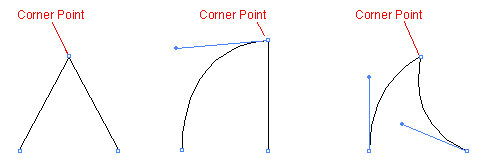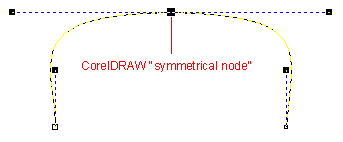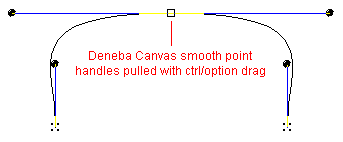Continuing with the anatomy of vector illustrations, let's now take a look at ANCHOR POINTS (or simply points or nodes...please refer to the table of equivalent terminology in the illustration section of the web site).
Anchor Points
Anchor points are the basis of all objects in a vector illustration and are its most fundamental components. Anchor points have only a few basic properties. However, there are many combinations of these basic properties that result in several variations of anchor points. This can appear overly complex at first glance. The pattern outlined here is very simple and explains all the variations.
All line segments have anchor points at each end which define their position and curve attributes. The name for the resulting curves are called Bezier (pronounced beh-zee-ay) curves. They are named after the French mathematician, Pierre Bezier, who developed a method for defining curves mathematically.
 All anchor points fall roughly into two categories:
All anchor points fall roughly into two categories:1. Those having CONTROL HANDLES and
2. Those having NO CONTROL HANDLES

Curves are controlled by control handles extending from the points. These control handles do not print. The direction and magnitude of curves entering and leaving anchor points are determined by the direction and length of the control handles.
Each control handle extending from a point controls only the portion of the curve of the line segment facing the control handle:

Line segments with points having control handles are curved.
Line segments with points having no control handles are straight.

A point can have either:
1. ONE CONTROL HANDLE or
2. TWO CONTROL HANDLES
There is really only ONE handle per SIDE of a point because points between consecutive line segments are shared.

Points with both handles in line with each other are called SMOOTH POINTS. All other points (except for two specialized ones shown below) are generally referred to as CORNER POINTS.

Line segments whose curves do not transition smoothly together are joined by corner points.
The corner point shown above has two handles but a corner point can also have one handle, no handles, join a curved line segment to curved line segment, join a straight line segment to a curved line segment or a straight line segment to a straight line segment. Below are samples of corner points:

Some point types are unique to certain applications.
CorelDRAW has a specialized smooth point called a "symmetrical node". The lengths of both control handles of a symmetrical node remain equal when either one of them is adjusted:



Click Here To Continue...




0 Reactions to this post
Add CommentPost a Comment